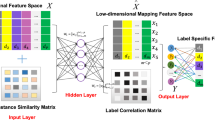Abstract
Multi-instance multi-label learning (MIML) is an innovative learning framework where each sample is represented by multiple instances and associated with multiple class labels. In several learning situations, the multi-instance multi-label RBF neural networks (MIMLRBF) can exploit connections between the instances and the labels of an MIML example directly, while most of other algorithms cannot learn that directly. However, the singular value decomposition (SVD) method used to compute the weights of the output layer will cause augmented overall error in network performance when training data are noisy or not easily discernible. This paper presents an improved approach to learning algorithms used for training MIMLRBF. The steepest descent (SD) method is used to optimize the weights after they are initialized by the SVD method. Comparing results employing diverse learning strategies shows interesting outcomes as have come out of this paper.



Similar content being viewed by others
Explore related subjects
Discover the latest articles, news and stories from top researchers in related subjects.Notes
A Founder server with 4G RAM and Intel Xeon E5504 CPU is used to conduct the experiments.
References
Zhou Z-H, Zhang M-L (2007) Multi-instance multi-label learning with application to scene classification. In: B Schǒlkopf, J Platt, T Hoffman (eds) Adv Neural Inf Process Syst 19: 1609–1616
Zhang M-L, Wang Z-J (2009) MIMLRBF: RBF neural networks for multi-instance multi-label learning. Neurocomputing 72:3951–3956
Chen W, Jiao L (2010) Adaptive tracking for periodically time-varying and nonlinearly parameterized systems using multilayer neural networks. IEEE Trans Neural Netw 21(2):345–351
Chen W, Jiao LC, Wu J (2011) Decentralized backstepping output-feedback control for stochastic interconnected systems with time-varying delays using neural networks. Neural Comput Appl. doi:10.1007/s00521-011-0590-x
Zhao Z, Shan X (2007) Optimization approach based on genetic algorithm for RBF neural network (in Chinese). Comput Eng 33(6):211–212
Bishop CM (1995) Neural networks for pattern recognition. Oxford University Press, New York
Dietterich TG, Lathrop RH, Lozano-Pérez T (1997) Solving the multiple-instance problem with axis-parallel rectangles. Artif Intell 89(1–2):31–71
Schapire RE, Singer Y (2000) BoosTexter: a boosting-based system for text categorization. Mach Learn 39(2–3):135–168
Boutell MR, Luo J, Shen X, Brown CM (2004) Learning multi-label scene classification. Pattern Recogn 37(9):1757–1771
Zafra A, Romero C, Ventura S (2011) Multiple instance learning for classifying students in learning management systems. Expert Syst Appl 38:15020–15031
ZhouZ-H, Zhang M-L, Huang S-J, Y-F Li (2008) MIML: a framework for learning with ambiguous objects, CORR abs/0808.3231
Gǎrtner T, Flach PA, Smola AJ (2002) Multi-instance kernels. In: Proceedings of the 19th international conference on machine learning, Sydney, pp 179–186
Smola AJ, Vishwanathan SVN, T. Hofmann (2005) Kernel methods for missing variables. In: Proceedings of the 10th international workshop on artificial intelligence and statistics, Barbados, pp 325–332
Kelley JE (1960) The cutting-plane method for solving convex programs. J Soc Ind Appl Math 8(4):703–712
Edgar GA (1995) Measure, topology, and fractal geometry. 3rd print, Springer, Berlin
Zhang M-L, Zhou Z-H (2009) Multi-instance clustering with applications to multi-instance prediction. Appl Intell 31(1):47–68
Montazer GA, Sabzevari Reza, Ghorbani Fatemeh (2009) Three-phase strategy for the OSD learning method in RBF neural networks. Neurocomputing 72:1797–1802
Cohen S, Intrator N (1996) Global optimization of RBF networks. IEEE Trans Neural Netw 7(4):969–984
Maron O, Ratan AL (1998) Multiple-instance learning for natural scene classification. In: Proceedings of the 15th international conference on machine learning, WI, pp 341–349
Zhang M-L, Zhou Z-H (2008) M3MIML: a maximum margin method for multi-instance multi-label learning. In: Proceedings of the 8th IEEE international conference on data mining (ICDM’08), Pisa, pp 688–697
Sebastiani F (2002) Machine learning in automated text categorization. ACM Comput Surv 34(1):1–47
Andrews S, Tsochantaridis I, Hofmann T (2003) Support vector machines for multiple-instance learning. Adv Neural Inf Process Syst 15, MIT Press, Cambridge, pp 561–568
Acknowledgments
This work is supported by the Fundamental Research Funds for the Central Universities (No. 09CX04031A). The authors are grateful for the anonymous reviewers who made constructive comments.
Author information
Authors and Affiliations
Corresponding author
Rights and permissions
About this article
Cite this article
Li, C., Shi, G. Weights optimization for multi-instance multi-label RBF neural networks using steepest descent method. Neural Comput & Applic 22, 1563–1569 (2013). https://doi.org/10.1007/s00521-012-0815-7
Received:
Accepted:
Published:
Issue Date:
DOI: https://doi.org/10.1007/s00521-012-0815-7




